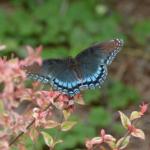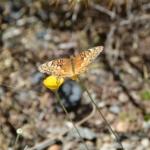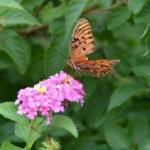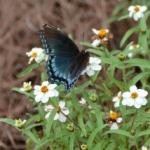Pollinators in the Landscape I: Importance of Pollinators and Causes of Decline
Photos by Mandy Bayer
The Importance of Pollinators
Concerns about honeybee populations and monarch butterfly migration have brought attention to the need to protect and support pollinators in the landscape. To understand the importance of pollinators, it is necessary to have an understanding of pollination. There are two types of pollination, self-pollination in which a plant is able to pollinate itself without outside help, and cross-pollination which is pollination aided by animals, wind, and water. The majority of pollination is cross-pollination with animal assisted pollination accounting for around 75%. Pollination is necessary for fruit development, seed production, and can result in better quality of some fruits (such as tomato). Almost all fruit and grain crops grown in the US require pollination (over 150 crops!) and crops dependent on pollinators are estimated by the USDA to be worth more than $10 billion per year.
Pollinator Decline
Pollinator decline is an area of controversy and concern, with the growing consensus being that it is not a singular cause, but a combination of multiple stressors leading to population declines. Pesticides, with a focus on neonicotinoids, are one of the most controversial contributors to decline. The concern with pesticides and herbicides is twofold: 1) the direct health implications of pesticides on pollinators and 2) the use of herbicides in cropping systems, which creates monocultures that poorly support pollinators by reducing the variety of flowering plants in the area. The issue with neonicotinoid insecticides is that they travel systemically throughout the plant, including to pollen and nectar, increasing the likelihood of pollinator contact.
Loss of suitable habitats is another cause of concern. Urbanization and land conversion have contributed to loss of habitat. A combination of habitats is needed for food, nesting and mating areas, and migration. Urbanization has led to the fragmentation of habitats and the disruption of some migratory pathways. Land conversion from diverse natural landscapes to intensive cropping areas that are almost monocultures, decreases the variety of pollen and nectar sources for pollinators. Flowers vary in protein content and nutrient composition, so a diet of a singular plant species has the potential to impact pollinator health.
Transportation of bees and an increase of commercial bee colony trade have contributed to the spread of parasites and diseases outside of the normal range. The spread of parasites and pathogens is problematic because the new host species often lacks resistance, increasing the likelihood of death.
The impact of current and future climate change on pollinators is not yet well understood. Historically, changes in climate have caused the native ranges of plants and animals to shift to where conditions are more favorable. Many plants and pollinators have evolved to have a mutualistic dependency, so with potential range shifts there is concern that plant and pollinators will shift in different directions. Range shifts due to climate change have already been observed with some butterflies. Another concern is the alteration of bloom time and pollinator emergence. Climate change has the potential to lead to earlier warmer temperatures in the spring, which could disrupt the synchronization of flower development and pollinator emergence. There may also be increased potential for flower and bud damage due to increased frequency of late frost events if warmer temperatures come early.
The good news is that urban landscapes have great potential to support pollinators, both as nectar and pollen sources and as pollinator habitats.
Pollinator Plant Spotlight: Milkweed
Milkweed (Asclepias spp.) is the larval host plant for the monarch butterfly, meaning that milkweed is the only plant that monarch caterpillars feed on. Many plants and their pollinators have evolved together creating mutualistic dependencies. Milkweed contains toxins that are not harmful to monarch caterpillars, but are poisonous to many animals, providing protection for monarchs both as larval caterpillars and as adult butterflies.
| Milkweed species for the Northeast: | |
|---|---|
|
Asclepias incarnata |
Swamp milkweed |
|
Asclepias tuberosa |
Butterflyweed |
|
Asclepias verticillata |
Whorled milkweed |
|
Asclepias exaltata |
Poke milkweed |
Pollinator Highlight: Butterflies and moths
Butterflies have four life stages: egg, caterpillar, pupa, and adult; all of which have differing habitat needs. There are many habitat options for butterfly eggs including leaves or branches of various plants and the soil. Larval, or caterpillar, host plants are much more limited (for example Monarch butterflies and milkweed) and need to provide the caterpillar with both food and shelter. At the pupa stage butterflies need a protected area, such as shrubs, tall grasses, or fallen branches. As adults, butterflies need plants that provide a nectar source. Butterflies are attracted to flowers that are brightly colored, open during the day and provide a good landing platform. Nectar is usually deeply hidden within the flower; however butterflies are able to use nectar guides to find nectar. Nectar guides are markings on flowers that are not visible to humans but can be seen by pollinators and direct them to nectar. While some butterfly species migrate in the winter, others hibernate, requiring leaf litter, bark, or other landscape debris as cover.
Moths can be either nocturnal or day-time pollinators depending on the type, with the majority being nocturnal and very important for the pollination of night blooming flowers. They are generally attracted to white or dull colored flowers that are heavily fragranced.
Plant features for attracting butterflies include:
- Bright colored flowers
- Wide landing pad
- Tubular flowers
Plant features for attracting moths include:
- Pale/dull colored flowers
- Strongly sweet fragrance (especially at night)
- Tubular flowers
Plants for Butterfly Gardens
Plants that attract butterflies (nectar sources):
|
Annuals |
||||
|---|---|---|---|---|
|
Scientific Name |
Common Name |
Size |
Color |
Bloom Time |
|
Cosmos bipinnatus |
Cosmos |
12-48" |
pink, red, white |
June to frost |
|
Lantana camara |
Lantana |
36-48" |
yellow, pink, white, orange, red, purple, mixed |
July to frost |
|
Tagetes erecta |
African marigold |
12-48" |
yellow, orange, white |
June to frost |
|
Tagetes patula |
French marigold |
6-12" |
yellow, orange, red, bicolor |
June to frost |
|
Tithonia rotundifolia |
Mexican sunflower |
48-72" |
orange-red |
July to September |
|
Tropaeolum |
nasturtium |
12-36" |
red, orange, yellow, or cream |
May to September |
|
Zinnia spp. |
zinnia |
6-48" |
red, orange, yellow, pink, white, purple, cream |
June to frost |
|
Perennials |
|||||
|---|---|---|---|---|---|
|
Scientific Name |
Common Name |
Size |
Color |
Bloom Time |
Native |
|
Allium cultivars |
ornamental onion |
12-60" |
purple, lavender |
May-June |
|
|
Asclepias incarnata |
swamp milkweed |
48-60" |
white, pink, mauve |
July - August |
* |
|
Asclepias purpurascens |
purple milkweed |
24-36" |
pink to purple |
May- July |
* |
|
Asclepias tuberosa |
butterfly weed |
12-30" |
yellow/orange |
June-August |
* |
|
Aster spp. |
Aster |
12-24" |
purple, blue, lavender, white |
August - September |
some |
|
Coreopsis cultivars |
tickseed |
12-24" |
yellows |
June - October |
|
|
Coreopsis rosea |
tickseed |
12-36' |
pink |
June - September |
* |
|
Dianthus barbatus |
sweet William |
12-24" |
red, pink, white, bicolor |
May - frost |
|
|
Echinacea cultivars |
coneflower |
6-48" |
purple, pink, white, yellow, orange, lime |
June - August |
|
|
Echinacea purpurea |
purple coneflower |
24-60" |
purple/pink |
June - August |
* |
|
Eutrochium purpureum |
Joe Pye weed |
60-84" |
pink |
July - September |
* |
|
Gaillardia spp. |
blanketflower |
8-36" |
yellow, orange, red |
May - September |
|
|
Helenium cultivars |
sneezeweed |
12-48" |
red, orange, yellow |
August - October |
|
|
Lavandula angustifolia cultivars |
English lavender |
8-36" |
purple, lavender, pink, blue |
June - October |
|
|
Leucanthemum x superbum |
shasta daisy |
22-36" |
white |
July - September |
|
|
Liatris spicata |
blazing star |
8-18" |
purple |
July - August |
* |
|
Lobelia cardinalis |
cardinal flower |
24-48" |
red, white, or pink |
July - September |
* |
|
Lobelia siphilitica |
blue cardinal flower |
24-36" |
blue |
July - September |
* |
|
Monarda cultivars |
bee balm |
8-36" |
reds, pinks, or purples |
June - August |
|
|
Phlox paniculata cultivars |
garden phlox |
12-48" |
pink, red, white, purple, lavender, bicolor |
July - September |
|
|
Phlox subulata |
creeping phlox |
4-6" |
red, purple, lavender, pink, white |
March - May |
* |
|
Rudbeckia fulgida |
black-eyed Susan |
24-36" |
yellow/orange |
June - October |
|
|
Scabiosa 'Butterfly Blue' |
pincushion flower |
12-18" |
lavender blue |
April - frost |
|
|
Sedum spp. |
stonecrop |
2-18" |
pink, red, white |
July - September |
|
|
Symphyotrichum novae-angliae |
New England aster |
36-72" |
deep pink purple |
August - September |
* |
|
Shrubs and Trees |
|||||
|---|---|---|---|---|---|
Shrubs |
|||||
|
Scientific Name |
Common Name |
Size |
Color |
Bloom Time |
Native |
|
Aesculus parviflora |
bottlebrush buckeye |
8-12' |
white |
June-July |
|
|
Buddleja alternifolia |
alternate-leaved butterfly bush |
8-15' |
lilac purple |
May |
|
|
Buddleja davidii cultivars |
butterfly bush |
3-12' |
lilac, purple, pink, red, white |
June - September |
|
|
Ceanothus americanus |
New Jersey tea |
3-4' |
white |
May - July |
* |
|
Cephalanthus occidentalis |
buttonbush |
5-12' |
white |
June |
* |
|
Clethra alnifolia and cultivars |
sweet pepperbush/ summersweet |
2-8' |
white, pink |
July - August |
* |
|
Fothergilla gardenii |
dwarf fothergilla |
1.5-3' |
white |
April-May |
|
|
Kalmia latifolia cultivars |
mountain laurel |
2-15' |
pink, white, multicolor |
May - June |
* |
|
Kolkwitzia amabilis |
beautybush |
6-10' |
pink |
April-May |
|
|
Lindera benzoin |
spicebush |
6-12' |
yellow/green |
March |
* |
|
Rhododendron spp. |
Rhododendron and azalea |
||||
|
Syringa vulgaris cultivars |
common lilac |
3-16' |
lavender, purple, white, pink, blue |
May |
|
|
Vaccinium spp./cultivars |
blueberry |
3-12' |
white |
May |
* |
|
Viburnum spp. |
viburnum |
2-20' |
white |
April - June |
some |
Trees |
|||||
|
Aesculus glabra |
Ohio buckeye |
20-40' |
greenish yellow |
April - May |
|
|
Amelanchier spp. |
Serviceberry |
6-25’ | white | April - May | * |
|
Cornus florida and cultivars |
flowering dogwood |
15-30' |
white, pink |
April - May |
* |
|
Malus cultivars |
flowering crabapple |
7-30' |
white, pink, coral |
||
|
Prunus spp. |
cherry, flowering almond |
10-40' |
white, pink |
March - April |
|
Host Plants (plants that caterpillars like to feed on):
|
Larval Host Plants |
|||
|---|---|---|---|
|
Scientific Name |
Common Name |
Size |
Native |
|
Alcea rosea |
hollyhock |
5-8' |
|
|
Anethum graveolens |
dill |
3-5' |
|
|
Asclepias spp. |
milkweed |
24-60" |
|
|
Artemisia spp. |
wormwood |
6-36” |
|
|
Aster spp. |
aster |
12-24” |
|
|
Carex |
sedge |
0.5-1.5' |
|
|
Echinacea purpurea |
coneflower |
18-36” |
|
|
Panicum |
switch grass |
2.5-6' |
|
|
Petroselinum crispum |
parsley |
0.5-1' |
|
|
Schizachyrium scoparium |
little bluestem |
2-4' |
|
|
Sedum spp. |
stonecrop |
2-18" |
|
|
Viola spp. |
violet |
4-12" |
some |
|
Aesculus glabra |
Ohio buckeye |
20-40' |
|
|
Amelanchier spp. |
serviceberry |
15-30' |
some |
|
Betula spp. |
birch |
30-70' |
some |
|
Carpinus caroliniana |
hornbeam |
20-35' |
* |
|
Ceanothus americanus |
New Jersey tea |
3-4' |
* |
|
Cephalanthus occidentalis |
buttonbush |
5-12' |
* |
|
Cercis canadensis |
redbud |
20-30' |
* |
|
Clethra alnifolia and cultivars |
sweet pepperbush/ summerweet |
2-8' |
* |
|
Cornus florida |
flowering dogwood |
15-30' |
|
|
Cornus alternifolia |
pagoda dogwood |
15-25' |
|
|
Fraxinus spp. |
ash |
35-80' |
some |
|
Lindera benzoin |
spicebush |
6-12' |
* |
|
Populus spp. |
poplar, aspen |
30-80' |
some |
|
Quercus spp. |
oak |
30-80' |
some |
|
Rhododendron spp. |
rhododendron and azalea |
2-12' |
some |
|
Rhus spp. |
sumac |
1.5-30' |
some |
|
Sassafras albidum |
sassafras |
30-60' |
* |
|
Salix spp. |
willow |
20-40'+ |
some |
|
Syringa vulgaris cultivars |
common lilac |
3-16' |
|
|
Vaccinium spp./cultivars |
blueberry |
3-12' |
* |
|
Viburnum spp. |
viburnum |
2-20' |
some |
|
Ulmus spp. |
elm |
30-80' |
some |
Sources:
Goulson, D., E. Nicholls, C. Botias, and E.L. Rotheray. 2015. Bee declines drive by combined stress from parasites, pesticides, and lack of flowers. Science 26 Feb 2015.
USDA Forest Service. Pollinators. https://www.fs.fed.us/wildflowers/pollinators/animals/
USDA Forest Service. Plant Milkweed for Monarchs. https://www.fs.fed.us/wildflowers/pollinators/Monarch_Butterfly/documents/MilkweedInfoSheet.pdf
University of Maine Extension. Landscaping for Butterflies in Maine. https://extension.umaine.edu/publications/7151e/
Massachusetts Butterfly Club. http://www.naba.org/chapters/nabambc/downloads/Butterfly%20gardening%20101%20-%20Western%20Massachusetts.pdf
USDA Natural Resources Concervation Service and the Wildlife Habitat Council. Native Pollinators. https://plants.usda.gov/pollinators/Native_Pollinators.pdf
UMass Center for Agriculture Food and the Environment. Protecting Bees and Pollinators from Pesticides in Home Gardens and Landscapes. https://ag.umass.edu/home-lawn-garden/fact-sheets/protecting-bees-pollinators-from-pesticides-in-home-gardens-landscapes
Missouri Botanical Garden Plant Finder http://www.missouribotanicalgarden.org/plantfinder/plantfindersearch.aspx



